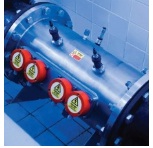 Add My Company
Add My Company
Sign In

Ultraviolet (UV) light is increasingly being used as an effective barrier for Cryptosporidium and other emerging chlorine resistant organisms in the United Kingdom. Many leisure operators are now installing UV systems as standard to ensure their water does not pose a risk to public health. This article examines the dangers posed by Cryptosporidium and how Ultraviolet disinfection can minimize the risk of an outbreak. Understanding the problem
Found in water supplies all over the globe, Cryptosporidium outbreaks are now becoming more and more frequent causing severe illness that can be fatal to vulnerable groups such as the young and elderly and in a number of cases has lead to costly and drawn out legal action.
The problem is, whilst disinfection with chlorine effectively destroys other pathogens - it takes less than one minute to eradicate E. coli, and approximately 16 minutes to kill the Hepatitis A virus - cryptosporidium is virtually immune. Due to a thick outer membrane, it takes more than 10 days to destroy cryptosporidium in a normal pool (25 degrees with free chlorine levels of 1ppm, a pH of 7.5 and no chlorine stabilisers) according to the U.S. Centre of Disease Control.
The most common forms of the pathogen are Cryptosporidium C. homius or Cryptosporidium paravum, commonly found in livestock. Both cause severe gastrointestinal symptoms in humans, including diarrhea, stomach cramps, vomiting and nausea, which can lead to fever and excessive dehydration. Infections typically last between one and two weeks, but some e.g. those with a weaker immune system such as the very old or the very young, may develop more severe or chronic symptoms leading fatalities.
Cryptosporidium propagates itself by using its host to spread oocysts (eggs) that then infect others. These oocysts latch onto cells in the intestinal tract, where the parasite reproduces. It then exits the body through the stool ready to infect another person. In swimming pools, cryptosporidium is generally spread via diarrhea (accidents), which release millions of crypto oocysts into a pool environment from a single fecal incident. As it only takes 10 to 30 occysts to become infected, simple bad hygiene such as not washing hands after using the toilet or changing a nappy can easily cause an outbreak.
Minimising the risks
The most significant step any leisure operator can take to avoid an outbreak of Cryptosporidium is education. By informing users of the risks and the action that they can take, such as showering before entering the pool, washing their hands after using the toilet and avoiding pool use during and after periods of sickness, operators can vastly reduce the risk of introducing Cryptosporidium into the pool environment. However, no amount of education will protect users from outbreak once pool water becomes infected.
For more information on UV Disinfection Provides Protection Against Cryptosporidium talk to atg UV Technology
Enquire Now
List your company on FindTheNeedle.

